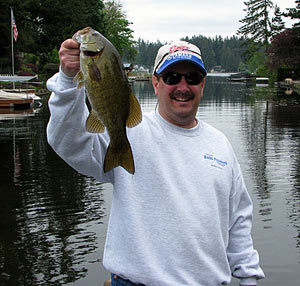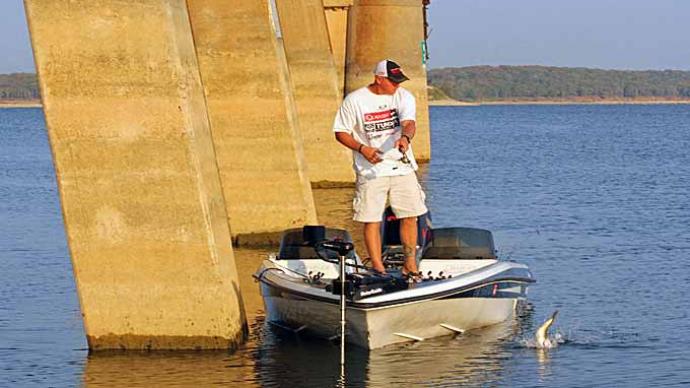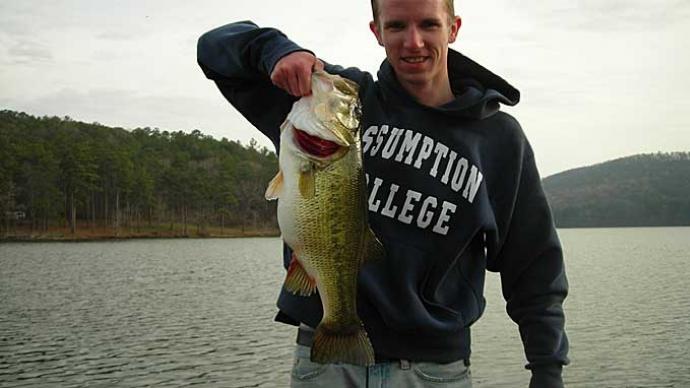
We who live in the Midwest are blessed. We get to witness, center stage, the four seasons that Mother Nature sends our way every year. In the fall, we get to choose between grabbing guns or continuing with rods. Winter leads us into the ice fishing season. You have to love ice fishing, fishing through a small hole, on ice thick enough to drive a truck on.
Nighttime temperatures reaching twenty below zero make it a little tough to get through the winters up north. That could be why many people across the country question our sanity. All I can say to that is, just once, all they have to do is go fishing for smallies on a spring day on one of the Great Lakes. They, too, will then be asking where to buy some of those warm winter clothes.
I have been a diehard bass fisherman for almost all of my life. I have been hooked on largemouth ever since the first one grabbed the cork popper I was working across the lake surface. As a kid, many days when I was not playing baseball, I would be wading the lake a block from my house with a fly rod in hand, seeing how many fish I could catch that day. Most of the time, bluegills were my target fish, but I would often hang closer to the lily pads to see if I could get a few bass to bite.
Once I started tournament bass fishing, I was introduced, up close and personal, to Mr. Bronze Back. These days, if I had to choose between fishing for largemouth or smallmouth, I would have to say that smallmouth is the fish that I would pursue day in and day out. Unfortunately, I'm only able to get my Great Lakes smallie fix about six times a year these days.
In my opinion, springtime is the most exciting smallie bite of the season. Smallies start to head into the shallower cuts off of the main lake in preparation for the spawn. This movement will be like many other lakes except that, when you're fishing the Great Lakes, there is more water, and with more water, there is the bonus of more fish. During the spring, you will see waves of fish move in, spawn, and move back out as the next wave moves in. The smallies will be in and out on smaller lakes in a few weeks, but the spawning season can last nearly a month on the Great Lakes.
Once ice-out happens, and the sun starts to work, water temperatures start to climb, and the first wave of smallies make their trek towards the shallows. Smallies will start by holding in deeper water outside the spawning areas, waiting for the low fifties' temperature. When the smallies are in the deeper water, they are schooled tight, so you will likely find more in the area if you can find one. The target depth to look for here is eight to twelve feet. If the day is warmer, they will move shallower, but they will move deeper to ride out the weather change if faced with a cold front. Use the current weather conditions to make the proper depth adjustment.
When fishing these conditions looking for pre-spawn smallies, jerkbaits make a perfect choice to cover water looking for biters. My first choice in this style of bait is a Rapala Deep X-Rap when the smallies are sitting in the deeper ten- to twelve-foot range. This bait will get down deep enough to get bites when the smallies are just starting to come out of deep water and start to stage, waiting for the temperature to rise. Another bait choice that will fish deep is the X-Rap Shad. Cast this bait out, pull it down and use a stop-and-go retrieve back to the boat.
If the smallies are riding out a cold front passing through, I'll switch and use an Outkast Touchdown Jig rigged with a Spider Grub. Smallies will hold close to the bottom during cold front conditions, so nothing works better than a Touchdown Jig to get in their zone. Cast it out, let it settle to the bottom, then go to work. Drag the jig along the bottom, and work slowly. The smallies will be sluggish and in a non-chasing mood. If you think you're fishing slow enough, fish even slower during harsh cold front conditions.
As water temperatures climb to the high fifties, smallies will move to shallower water. It's time to break out the suspending jerkbaits. A #10 X-Rap will get the nod if the smallies are active. I will use a #10 Husky Jerk if they are still on the slow side. The difference between the two baits is that the X-Rap is a slash bait and has a little more side-to-side action than does the Husky Jerk. When the smallies are active and eating, the X-Rap will be the bait of choice, but Husky Jerks will get you more fish by the end of the day when they are a little subdued.
When the temperature reaches the low sixties, smallies will start to roam the shallows looking for prey and for areas to spawn. This is when you start to see action as you have never seen if you have never fished the Great Lakes before. You must cover water with subtle baits. In my years, I have found that a simple grub and jig combination works best for when the smallies are just hitting the shallows. Outkast's Money Jig tipped with a Fat Tail Grub makes a perfect combination. 3/32, 1/8, and 3/16 ounce Money Jigs tipped with Green Pumpkin/Green Flake Fat Tail have been the best combination in the spring, with Watermelon/Red Flake running a close second for me. Fishing this bait presentation is simple, make your cast and slowly start to reel. When the line straightens out, set the hook. You have a bite.
If the bite is slow or you're faced with fishing through a cold front, try a Money Jig tipped with a Stick Worm. You can fish this bait combination in two different ways. Either swim the Stick Worm back to the boat or fish it with a traditional lift and drop retrieve. If you're going to swim the Stick Worm, fish the bait just like you would the grub. Make your cast, count down the bait to the depth you want to fish, and slowly start to reel. When your line tightens, set the hook.
If you're planning to fish the Stick Worm with a traditional lift and drop method, adjust the size of the Money Jig before you start. Downsize the jig to 1/16 or 3/32 ounce. This will give the bait more glide as the bait falls. This is key in getting the smallies to bite when conditions are tough. Make your cast and let the bait settle to the bottom. This will take longer with the smaller jig, so be patient and pay close attention as the bait falls. With the lift and drop retrieve of this bait, many of your bites will come when the bait is falling or when you raise the rod tip to move the bait. With either retrieve method, let the smallies tell you what they want.
Don't let another spring pass before you decide to take advantage of the Great Lakes smallie bite. Tactics are pretty straightforward. Grab yourself a handful of jigs, a few tails, some jerk baits, and away you go. It's all over when the smallies hit the shallows except for the catching part.
Please, don't target smallies that are sitting on beds. Let them spawn. There will be enough smallies in the shallows that you won't have to target spawning fish.




